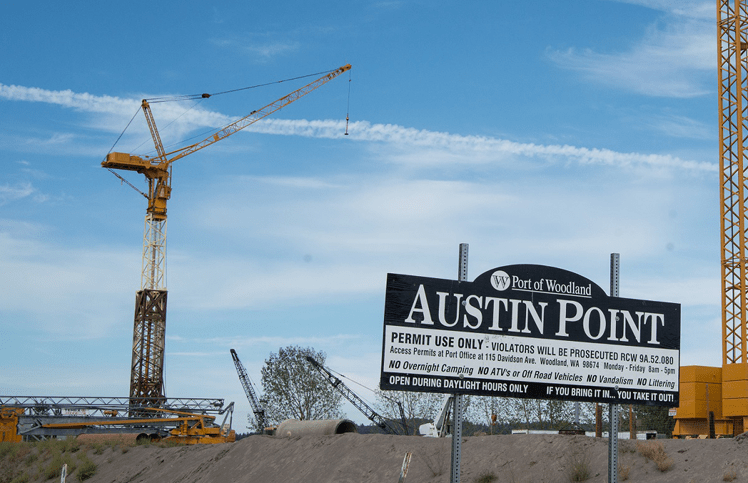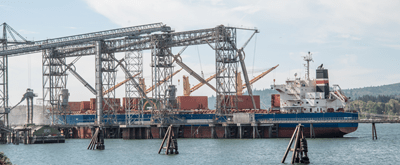Editor’s note: This “Ports of Progress” article is part of a continuing series of stories examining the economic impact that ports in Southwest Washington have on the region and in the communities they operate in.
According to the United States Census Bureau, Cowlitz County comprised just under 1.5 percent of Washington state’s population in 2014. They may all service smaller towns, but the economic impact of the ports of Longview, Kalama and Woodland are significant for their immediate communities and the port system collectively.
Port of Longview
Hard numbers offered up by Ashley Helenberg, director of external affairs, from their most recent economic impact analysis revealed that the Port of Longview is responsible for one in 10 local jobs, generates $444 million for local business and collects $5.2 million in tax revenue.
As Southwest Washington’s first full-service port along the deep-draft shipping channel of the Columbia River, Longview continues to strike a balance between innovation and traditional port business. In 2014 it became the second West Coast port to join the fast-growing Green Marine initiative. Green Marine is an environmental program comprised of ship owners, seaways, terminals and shipyards as well as over 25 ports throughout the U.S. and Canada. A detailed annual assessment completed by participants of this voluntary program documents their environmental performance.
The port’s director of environmental services, Lisa Hendriksen, praises Green Marine as “a great fit for the Port of Longview.” She added that “it gives us an avenue in which we can demonstrate our environmental sensibility, responsibility and sustainability.”
For the first time in its history, the port will operate a park and it’s looking to the community for significant input of future upgrades. The 75-acre Willow Grove Park sits along the bank of the Columbia River and meets the goal of the port to increase waterfront access.
Projects currently underway at Longview’s port include the redevelopment of Berth 4, one of its eight marine terminals. Unoccupied since the Continental Grain facility vacated it in 1989, the port is dismantling it for future use. Timber decking was removed in 2014 along with the 1,000 creosote pilings that made up its dock and construction of a new berth is slated for this fall with the final design dependent on the new tenant. Interest has been expressed by Haven Energy Terminals, but no agreement has been signed as yet.
In the master planning stages is the 280+ acre purchase of Barlow Point. Possibilities for this undeveloped waterfront property with deep-water access are being outlined by Northwest-based KPFF Consulting and necessary infrastructure will be determined based on their final design.
Down river at the Port of Kalama, marketing manager Liz Newman said, “We have the majority of the industrial property in the community. [There are] over 800 employees at the Port of Kalama with a community of 2,500 people; probably 33 percent of port employees [are residents] in Kalama, 33 percent in Cowlitz County and 33 percent in surrounding counties – so very impactful.”
An improving economy, accessible location and Kalama’s holistic approach to planning have its port buzzing with activity. Newman explained that port officials make very long-term plans in property acquisition and development, as well as relationship building with the city and other community partners, so that when businesses inquire about commercial space the port is prepared to service a variety of needs.
The Kalama River Industrial Park was developed to attract manufacturing and distribution companies. Tenants include Depin Packaging and lumber dry kiln parts and services company, Christianson Enterprises. Building space and land for lease is still available.
Depin Packaging, the parent company of ECORRCRATE, moved their operations of this less expensive crating solution to Kalama in June of this year and noted the port staff as paramount in their decision.
Dan Bonebrake, owner of Depin, said, “The location is key as we can service most of Oregon and Washington out of this one facility, and it is right off I-5. We were also very impressed with the people that work at the port. We feel they are more like partners than landlords and have been instrumental in helping us succeed during a difficult move. The facility is also perfect for what we need and is very impressive.”
Northwest Innovation Works (NWIW) – a methanol manufacturing facility to be located at the port – is in the early permitting phase and will bring $1.8 billion in capital investment, approximately 1,000 construction jobs over a several year period and 200 permanent family-wage jobs upon completion.
A spokesperson for NWIW explained that the methanol will be exported to Asia for use in the manufacture of olefins; a key component in many everyday consumer items.
“Kalama’s location is excellent, with a deep berth and easy access to the shipping channel,” said Simon Zhang, CEO of NWIW. “From the very first meeting, the Port of Kalama demonstrated that they are open for business. They are committed to their mission of generating economic growth for Kalama and have been excellent partners, introducing us to the community and working with us as we go through the permitting process and move toward construction.”
Master planning is also in the works with the city of Kalama for Spencer Creek Business Park, which will be located on port property at I-5 and Exit 32. Newman said that it will be mixed-use, bringing an estimated 900 jobs and $270 million in business revenue upon completion, which could take up to 20 years depending on market factors.
Port of Woodland
With a focus on developing industrial family-wage jobs, the Port of Woodland develops infrastructure on property from riverfront to I-5 exits, representing a range of industries from deep water to agricultural. According to executive director Jennifer Keene, the port is responsible for 16 different small to medium-sized industrial and some international companies – amounting to 300 family-wage jobs in Woodland.
Woodland’s port has a significant 8,000 feet of waterfront property on the Columbia River and deep water access at Austin Point and Martin Bar – properties currently being used as disposal sites for the Columbia River Channel Deepening Project. Nine acres of Martin Bar North will soon be available for economic development and is being actively marketed along with Austin Point. Its location one mile from Exit 22 is expected to make it a particularly attractive site.
Keene shared that industrial parks are vital to the region and, between Schurman Way, Down River and Rose Growers (all industrial parks), they’re able to offer 5,000-25,000 square feet of industrial space to serious inquirers.
Experiencing 100 percent occupancy on their buildings right now has led the port to begin its next industrial park: Guild Road Industrial Park. It’s slated to be 12 acres set aside for distribution transport and manufacturing purposes and designed to be five 25,000-square-foot buildings. Partial funding has been obtained with another $100,000 expected from the U.S. Department of Commerce’s Economic Development Admission (EDA). Keene said that the port has planned the park since purchasing the property in 2002 and their current customers are asking for larger spaces to expand operations into.
Also in the works is the surplusing of Pekin Industrial Park. Current tenants are in need of 15-20 acres and, after the port acquires a new building into which it will move its offices, an outright purchase of Pekin by the tenants will complete the process. Consulting firm BergerABAM has been hired by the port to compile a comprehensive scheme of harbor improvements with the goal of a 20-year projection on what to do with current properties and future acquisitions. Keene said the scheme will solidify what the Port of Woodland wants to be within the community, region and entire port system.
All ports working together
As members of the Washington Public Ports Association (WPPA), Longview, Kalama and Woodland recognize that they are stronger together and collaborate with other Columbia River ports on transportation and navigation issues that benefit the entire region. Collective advocacy through industry associations such as the Cowlitz Economic Development Council (CEDC) and partnerships with the local chamber and city promote a more global community focus even when participating in local economic decision-making policy.
Look for our next “Ports of progress” article in the September 4, 2015 edition of the Vancouver Business Journal. It will focus on the Port of Camas-Washougal and the Port of Skamania County.








